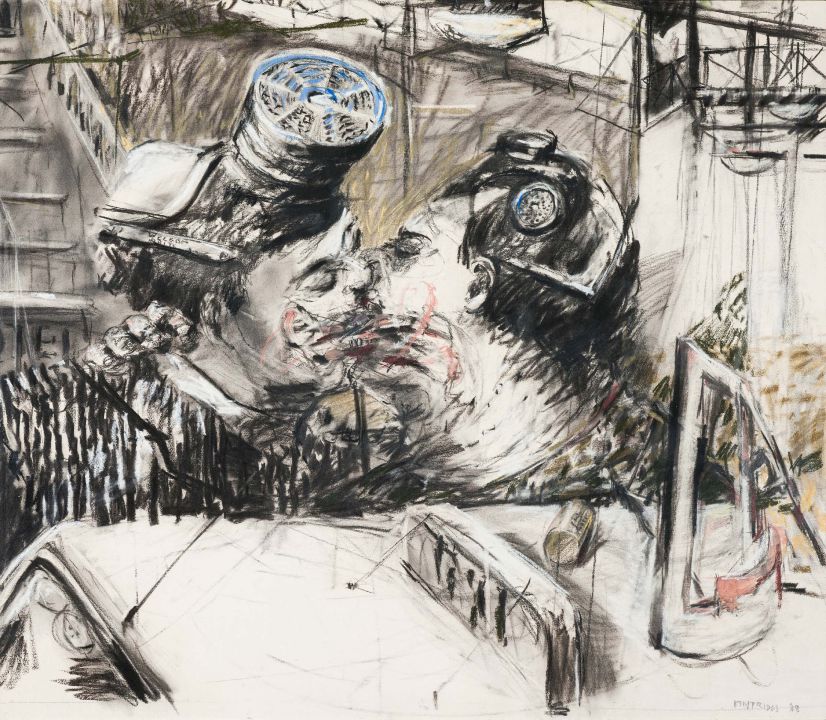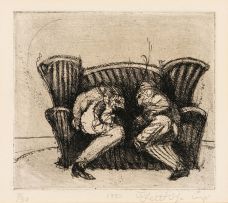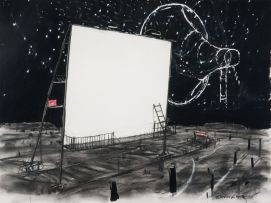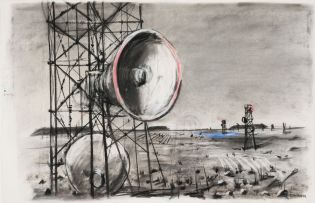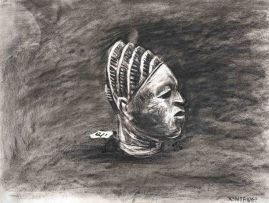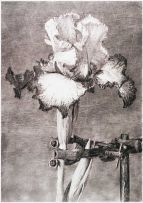Untitled Drawing Towards Responsible Hedonism
William Kentridge
Incl. Buyer's Premium & VAT
About this Item
signed and dated '88
Notes
William Kentridge's method as an artist is essentially iterative: visual motifs and artistic themes are progressively developed, refined and adapted over time. This lot derives from a period of sustained focus in the later 1980s on the moral quandaries of life in apartheid South Africa. Similar to the writing of Nadine Gordimer, a Kentridge family friend, the artist repeatedly returned to the habits, manners and environs of the white upper classes in his work from this time. These early drawings and prints are important precursors to Kentridge's celebrated stop-animation films, started in 1989, presenting in germinal form many of the subjects and ideas that would occupy his subsequent practice.
In 2004, the Italian-American curator and art historian Carolyn Christov-Bakargiev, a well-known international promoter of Kentridge's work, highlighted the significance of his early charcoal and pastel drawings in an exhibition she organised at Castello di Rivoli Museo d'Arte Contemporanea, Turin. "The second half of the 1980s constituted an intense period of experimentation, as Kentridge attempted to join draughtsmanship with his interests in politics and film," elaborates Christov-Bakargiev.1 His drawings from this period essentially functioned as test sites for his contradictory thoughts of South Africa's late bourgeois world.
"Drama, denunciation and melancholy are accompanied, however, by humour and irony, as well as by the numerous references to pleasure and desire that characterise all of Kentridge's art. As in Max Beckmann's prints and paintings, which Kentridge knew well, the drawings of this period are structured according to dramatic spatial angles ranging from compressed, dense spaces to deep, vertiginous ones, replete with figures and events."2
This lot directly references Kentridge's 1986 print series Industry and Idleness, which he based on (and also titled after) a 1747 engraving series by English printmaker William Hogarth. Kentridge's suite of eight prints relocates the action from London to Johannesburg and is significant for the introduction of a corpulent businessman in pin-stripe suit, an early prototype of Kentridge's Soho Eckstein protagonist. A print in the suite, Responsible Hedonism, includes a detail of an aristocratic couple kissing in a suburban swimming pool, which Kentridge returned in two drawings made in 1988.
The present lot has been described as a study towards a larger drawing also known as Responsible Hedonism.3 Visually complex, that drawing shows the kissing man and woman in reverse, and also incorporates a study towards the artist's 1989 drawing Casspirs Full of Love. Unlike poolside setting of the print and drawing both titled Responsible Hedonism, this lot presents two male figures taking leave of one another at a taxi waiting at the stairs to an unknown building. Both appear to be businessmen, one with possible links to industrial operations in Welkom and Brits. Their passionate kiss sees Kentridge adapt a familiar visual motif to further complicate his exploration of "guilt, complicity, agency, and resistance," enduring themes in his work.4
- Carolyn Christov-Bakargiev (2004). William Kentridge, Milan: Skira Editore, page 64.
- Ibid.
- Correspondence with Neil Dundas, Goodman Gallery, April 2017
- Maria-Christina Villaseñor (2005). William Kentridge: Black Box/Chambre Noire, Berlin: Deutsche Guggenheim, page 31.
